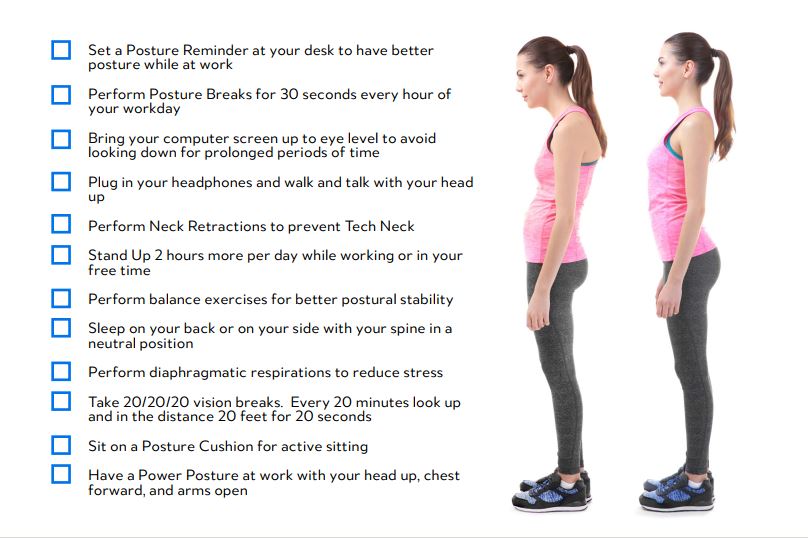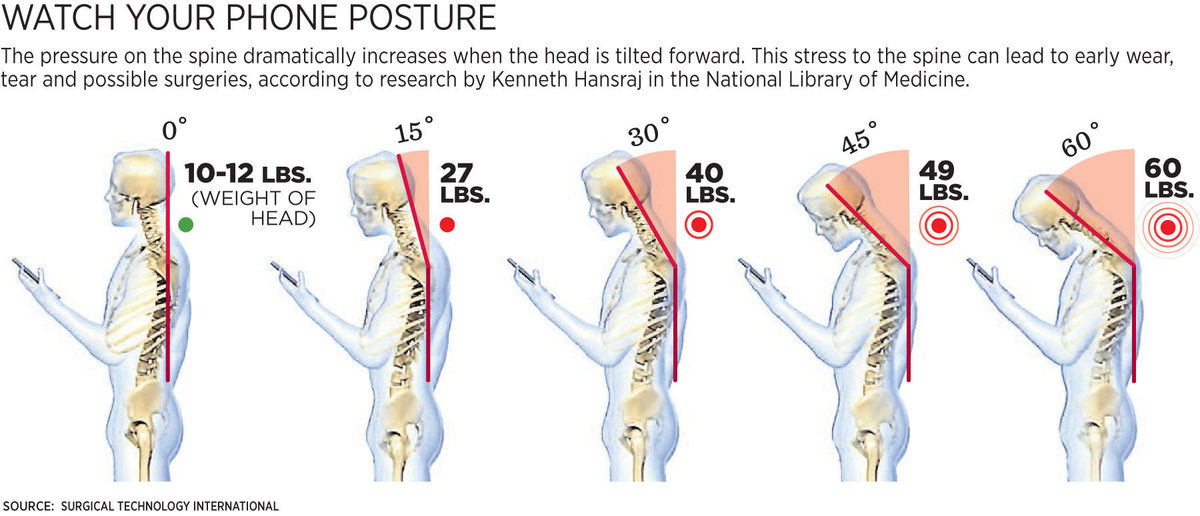|
Things will look a bit different in the office as we have made many changes to keep you and your family, and our team safe.
What we are doing to ensure your safety during your visit:
I often find poor sleeping habits contribute to chronic neck or back issues. A question I commonly get asked is: what is the best way to sleep for good posture? Read on to find out.
✅Sleeping on your back or side keeps your spine in the most neutral position, If you choose to sleep on your side, make sure to support your pelvis with a pillow between your knees. ✅Take a look at the type of pillow that you use. If you sleep on your back, you need a lower pillow. Remember that the neck is what really needs to be supported vs. your head. If you sleep on your side. there’s a bigger negative space between your head and shoulder, so you need a firmer and higher pillow. ✅Tuck the bottom of the pillow above the shoulders. The pillow should support your neck, not your shoulders. ✅Medium-firm mattress is best. A mattress that is too soft will cause the heaviest parts of your body to sink, while a too firm mattress will not support the curves of the spine. A good sleeping posture will improve the quality of your sleep, improving your overall energy and mood. Sweet dreams! Happy Posture Month! In honour of posture month, I will be posting posture tips on my Instagram page @drevechoe as well as some on the blog throughout the month of May.
How to fix the habits causing your bad posture so it doesn't ruin your look — or your backWritten by: Andrea Kerr for The Werk
If you work from a couch, or even from a desk, you've probably made peace with hunched shoulders and a mildly achy neck — but did you know that slouched posture has serious consequences for your image and your health? “If you have bad posture, people assume that you’re not confident,” says Eve Choe, a Toronto-based chiropractor who offers a 12-week posture workshop at her clinic. “You appear shorter and people assume you’re tired.” Poor posture also has negative health consequences like “chronic fatigue, muscle fatigue, headaches and back pain. You can have sleep and digestive problems, difficulty concentrating. It causes so many issues,” Choe says. But contrary to popular belief, super-straight military posture is not the ultimate goal. Instead, “good posture maintains three natural curves in the spine at the neck, mid-back, and low back,” says Choe. When you look in the mirror, your eyes should be level, as should your shoulders, hips, knees, and ankles. From the side, your ears, shoulders, hips, knees, and ankles should create a straight line that, again, maintains the natural curves in the spine. If you frequently notice that you appear slouched in photos or videos — or that your grandma’s always bugging you to sit up straight — try these tips for correcting the habits that cause bad posture in the first place. 1. Check your smartphone. Lately, the most common form of bad posture that Choe sees at her clinic is the forward head tilt — and one of the main causes is smartphone use. Many people spend hours on their phones each day texting, answering emails, and posting on social media, and they hold their phones in their laps, which causes neck strain. The correction? “Bring your smartphone to eye level instead of bringing your head down to it,” says Choe. 2. Adapt your workspace. “Laptops are built for portability,” Choe notes. “They’re not built for our bodies. Often, we will hunch forward so we can have our eyes level with the monitor of the laptop.” To correct this posture, consider purchasing an external keyboard or monitor so that you can space them to work for your body when your posture is at its best. Also, try to avoid sitting on soft couches or armchairs to work because they will likely raise your knees above your hips, which then rounds out your lower back. Instead, choose a chair that allows you to sit directly on your sit bones (not on your tailbone) with your knees at 90 degrees to your hips. 3. Take frequent breaks. It’s time to curb your habit of staring at your computer screen for three, four or five hours straight — even if you have the perfect office set-up. “A good tip is 20-20-20,” says Choe. “So every 20 minutes, try to get up for 20 seconds and look 20 feet away. It also gives your eyes a break.” If you can’t break every 20 minutes, aim for every hour. 4. Think long. Don’t think “straight” when you’re trying to correct your posture, because a healthy spine isn’t straight. Instead, imagine a string attached to the top of your head and pulling you upwards. Your shoulders should be back, yet relaxed, and you should maintain the natural curves in your spine. 5. Work it out. When working to correct bad posture, Choe gives her clients plenty of exercises to do at home. She loves head retraction and scapula retraction exercises, in particular. “For head retractions, you bring your head in toward the body with your chin tucked,” she says. “You don’t look down. You don’t look up. You bring your head straight back. With a scapula retraction, you squeeze your shoulder blades together.” Choe also likes to strengthen the muscles that stabilize her clients’ shoulder blades by recommending wall angels, which are snow angels performed up against a wall. 6. Change your sleep habits. How you sleep each night can have an effect on your posture throughout the day. “Sleeping on your back keeps your spine in the most neutral position, but side sleeping is also good,” says Choe. If you choose to sleep on your side, make sure you support your pelvis with a pillow between your knees. Also, take a look at the type of pillow that you use to support your head. If you sleep on your back, you need a low pillow. If you sleep on your side, “there’s a bigger negative space between your head and shoulder, so you need a firmer and higher pillow.” 7. Book an appointment with a chiropractor. A chiropractor can make adjustments that “restore mobility and movement back into the joints in the spine,” says Choe. These adjustments can also relieve stress that’s placed on the body when there’s a locked or restricted joint. After your adjustments, ask your chiropractor for additional at-home exercises to correct your specific posture concerns. Bad posture is a habit that you’ve developed over several years. Give yourself the time to correct it (Choe says it will likely take at least 12 weeks) and you’ll see improvements in your health and the image that you project to your colleagues, employers and future clients. Good posture is associated with better health and human function. Proper postural alignment protects the integrity of your internal organs and supports your body upright against the ever present force of gravity. Upright posture, with your head up and chest forward is associated with a higher level of self-perceived leadership and confidence. There are many preventable health consequences of poor posture. This checklist will help you look thinner in an instant, reduce stress, and increase your level of confidence. Yes, all those positive health affects are associated with your POSTURE. Let’s get to work. Original Author: Dr. Krista Burns
This isn’t another article about modern phone habits. We know we’re all working hard (right?). But you might want to watch your posture to avoid health issues.
Dr. Kenneth Hansraj, one of the top spinal surgeons in the United States, conducted a study on “text neck” and concluded that loss of the natural curve of the cervical spine can lead to early degeneration of the spine. His study showed that an adult head weighs an average of 10-12 lbs. in a neutral position. However, when you bend your head forward about 60 degrees to look down (like on your phone), your head is now the equivalent of 60 lbs to your body. Modern strains Because of modern-day hand-held technology, according to Dr. Scott Bautch, from the American Chiropractic Association, “When children have poor posture it tremendously speeds up the gaping of the spine. What we are seeing is degeneration of the spine at younger and younger ages.” But smart phones aren’t the only culprit in poor posture. Spending hours at a time at a desk, or watching TV, without moving can also be detrimental to your posture. Even with ergonomically designed furniture and standing desks, it’s important to break your posture, or move, every 15 minutes. “You develop imbalances and you are more likely to hurt yourself in any activity you do.” It’s all about balance By sitting in the same position for hours at a time, poor posture overworks one set of muscles while the other set of muscles are underworked. “You develop imbalances and you are more likely to hurt yourself in any activity you do,” concludes Dr. Bautch. There are things you can do to alleviate some of the modern-day stresses on your body and spine. For starters, always make sure your screen, whether computer screen or smartphone, is at eye-level so you aren’t hunching over. Dictate your texts — that’s what Siri is for. And of course, take a break every 15 to 30 minutes. Your body and mind will thank you for it. Source: Media Planet Some women carry the whole world in their handbag, but a heavy bag or purse can cause pain and injury to your back, neck and shoulders. Overstuffed bags also cause poor posture by encouraging the carrier to lean to one side. The good news is pain and injury can be easily avoided by following a few simple tips. Here are some provided by the Ontario Chiropractic Association:
Choosing a handbag 1. Choose a handbag that is proportionate to your body size and no larger than what is needed. Your handbag should not weigh more than 10 per cent of your body weight. 2. Choose a handbag that has several individual pockets, instead of one large compartment. This will help to distribute the weight of the contents more evenly and keep them from shifting. Packing a handbag 1. Change the size and weight of your wallet once in a while. You may also consider one wallet for your work and a different one for when you go out, as you may need different objects for both. 2. Ensure the weight is evenly distributed in the purse by using all the pockets. Carrying a handbag 1. Use both hands to check the weight of the handbag. 2. Instead of always carrying your handbag on the same shoulder, switch sides often so each shoulder gets a rest. 3. Square your shoulders — many women have a habit of lifting the shoulder on which the purse is carried to keep the straps from slipping. More tips 1. Try to maintain good posture. When standing, your head, shoulders, hips and ankles should line-up, one comfortably above the other. 2. If you can walk to lunch or a meeting, lock your purse in your desk or locker and carry only your cash and/ or credit cards in a pocket. By following these simple strategies, it’s easy to lighten your load. If you have any questions about posture and ergonomics, please contact Dr. Eve. |
AuthorDr. Eve Choe is a Toronto-based chiropractor, and certified posture expert, acupuncture & orthotics provider. Archives
November 2023
Categories
All
|

|
|










 RSS Feed
RSS Feed